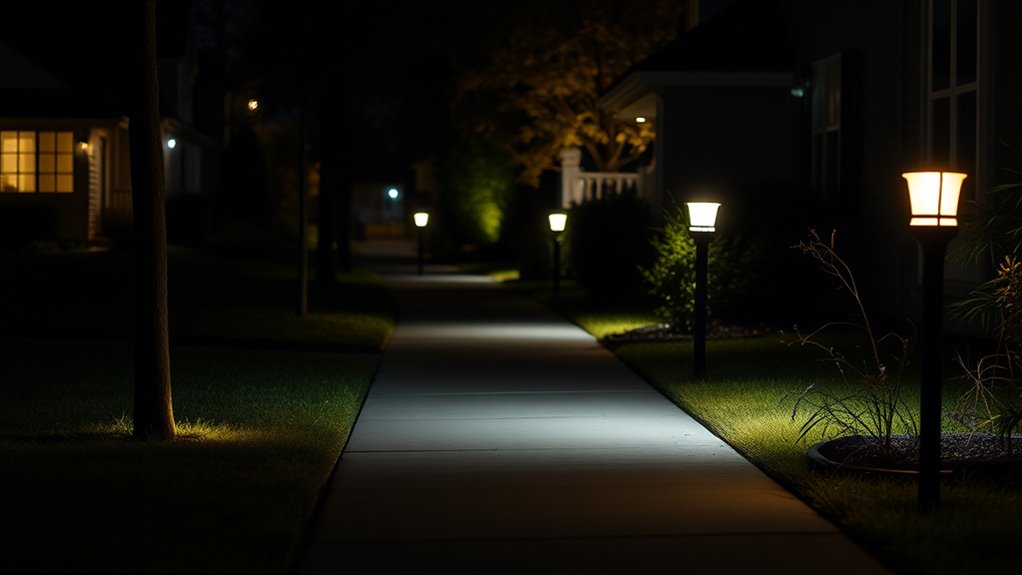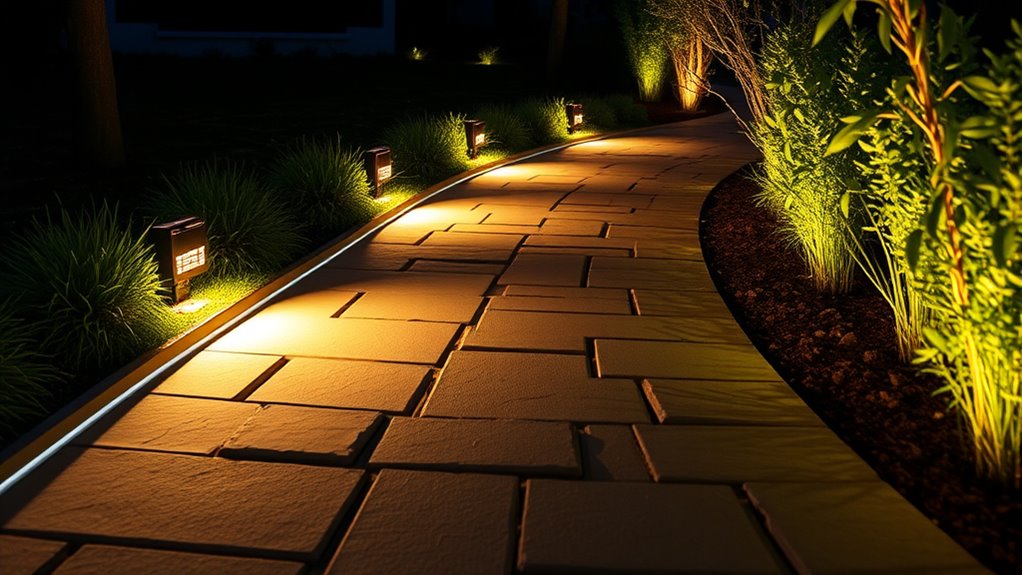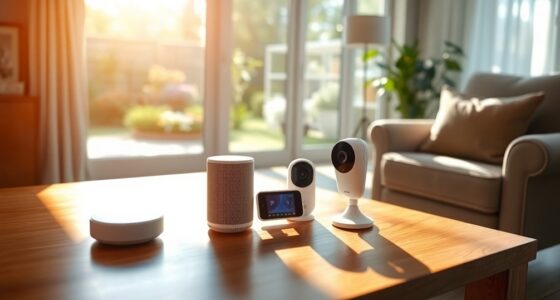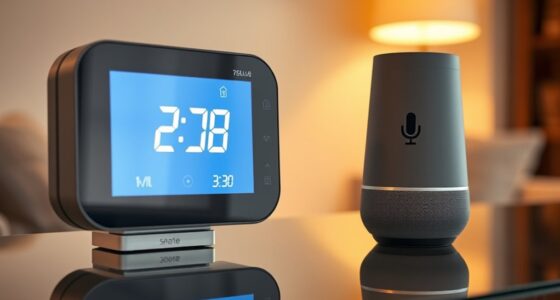Implementing lighting automation with motion sensors, pathway lights, and timers helps you enhance night safety by ensuring your outdoor areas stay well-lit when needed. Motion detectors activate lights instantly, while pathway lights guide you safely along walkways at dusk and dawn. Timers can schedule lights to turn on or off automatically, saving energy and improving security. To discover how these features work together seamlessly for your safety, keep exploring more about smart lighting solutions.
Key Takeaways
- Integrate motion sensors, pathway lighting, and timers for comprehensive night safety and energy efficiency.
- Use motion detection to activate lights instantly upon movement, enhancing security and visibility.
- Automate pathway lighting to ensure well-lit walkways from sunset to sunrise or scheduled times.
- Schedule timers to control lighting hours, reducing unnecessary energy use while maintaining safety.
- Combine these systems for a smart, responsive outdoor environment that deters intruders and improves navigation.

Lighting automation plays an essential role in enhancing night safety by guaranteeing areas are well-lit when needed and conserving energy when they’re not. With smart lighting systems, you don’t have to worry about manually turning lights on or off, which reduces the risk of accidents and deters potential intruders. Instead, these systems use sensors, timers, and programmable settings to activate lighting precisely when you need it most. This not only improves safety but also helps you save on energy costs, making your property more efficient overall.
One of the most effective features of lighting automation for night safety is motion detection. When you walk through a driveway, garden, or hallway, motion sensors detect your movement and trigger the lights to turn on immediately. This instant illumination helps you see clearly, avoiding tripping hazards, and gives a sense of security. Motion sensors are particularly useful in outdoor areas such as pathways, entrances, and perimeters, where sudden lighting can startle potential intruders or alert you to unexpected activity. They also prevent lights from staying on unnecessarily, which cuts down on energy waste, ensuring you’re not paying for electricity used when no one is around. Additionally, integrating smart technology with these systems can further enhance control and customization.
Pathway lighting is another critical aspect of automation that contributes to night safety. Automated pathway lights can be programmed to turn on at sunset and turn off at sunrise or at specific times. They follow predefined routes, providing consistent illumination along walkways, stairs, and driveways. When combined with motion sensors, pathway lighting becomes even smarter—lights only turn on when someone approaches or passes through, ensuring safe navigation without overusing electricity. This approach not only makes your outdoor spaces safer but also creates an inviting ambiance, guiding guests or family members safely home in the dark.
Timers are a simple yet powerful tool in lighting automation. You can set timers to keep lights on during certain hours, like late evenings or early mornings, and then turn off automatically. This ensures your property remains well-lit during critical times without you having to think about it. Timers work seamlessly with motion sensors and pathways, creating an integrated system that responds dynamically to your habits and needs. For instance, you might set your driveway lights to activate at dusk and turn off at dawn, with motion sensors providing additional illumination when needed. This combination guarantees safety, increases convenience, and maintains energy efficiency.
Together, motion sensors, pathway lighting, and timers form a holistic approach to night safety. They work harmoniously to keep your property illuminated when necessary, deter unwanted visitors, and reduce energy consumption. By investing in lighting automation, you create a safer, smarter environment that adapts to your lifestyle, providing peace of mind whether you’re at home or away.
Frequently Asked Questions
How Do I Choose the Best Lighting Automation System for My Home?
You should consider your home’s size, existing lighting setup, and your specific safety needs. Look for systems with easy installation, reliable motion sensors, and adjustable timers. Compatibility with your smart home devices is also key. Read reviews to gauge performance and customer support. Choose a system that offers user-friendly controls and energy efficiency to guarantee safety, convenience, and cost savings over time.
What Are the Energy Savings Associated With Lighting Automation?
Imagine your home glowing only when needed, saving energy like a smart, vigilant guardian. Lighting automation cuts your energy bills by turning lights off when rooms are empty and dimming them during low-traffic hours. You’ll see savings of up to 30% on electricity costs, reducing waste and lowering your carbon footprint. With these systems, you keep your home bright and safe while making eco-friendly choices effortlessly.
Can Lighting Automation Be Integrated With Existing Security Systems?
Yes, you can integrate lighting automation with your existing security system. It allows you to synchronize lights with security cameras, alarms, and sensors, enhancing your safety. You might need compatible hardware or software updates, but many systems support seamless integration through apps or control panels. By doing so, you’ll improve security, save energy, and gain more control over your lighting, making your home safer and more efficient.
How Does Weather Affect Outdoor Lighting Automation Performance?
Weather’s playful antics can turn your outdoor lighting into a temperamental diva. Rain and humidity might cause sensors to misfire, thinking a foggy night is a full-blown invasion. Snow can block motion detectors, and wind might trigger lights with every gust, making your system seem bipolar. So, you’ll need weather-resistant equipment and regular checks, or risk your lights acting like they’re auditioning for a drama series.
What Maintenance Is Required for Automated Lighting Systems?
You should regularly inspect your automated lighting system for dirt, debris, and damage. Replace or clean sensors and bulbs as needed to guarantee proper operation. Check connections and wiring for corrosion or wear, especially after severe weather. Update software or firmware if updates are available to keep your system secure and efficient. Scheduling routine maintenance helps prevent malfunctions, extends the system’s lifespan, and ensures reliable outdoor lighting for safety.
Conclusion
By automating your outdoor lighting with motion sensors, pathways, and timers, you create a safer environment after dark. Imagine your home remaining illuminated only when needed, reducing energy waste and preventing accidents. Did you know that properly lit outdoor spaces can reduce nighttime injuries by up to 50%? With smart lighting, you not only enhance safety but also save money and energy. Take control of your night safety today — your family and visitors will thank you.









